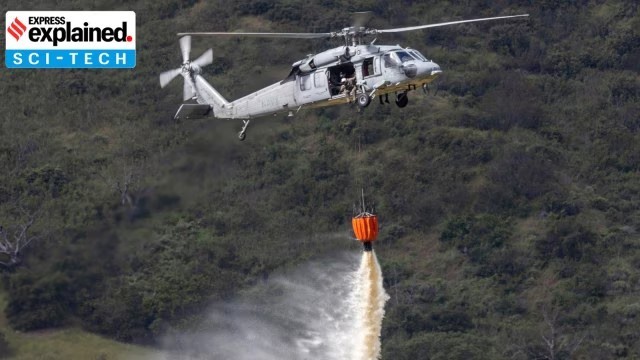
Bambi Bucket

29.04.2024
Bambi Bucket
|
For Prelims: About Bambi Bucket, About MI-17 V5 |
Why in the news?
Recently, Indian Air Force’s MI 17 V5 helicopter was deployed to extinguish the raging forest fires in Nainital and the helicopter used a “Bambi Bucket”.
About Bambi Bucket:
- It is also known as helicopter bucket or a It is a specialized aerial firefighting tool which has been in use since the 1980s.
- It is suspended by cable under a chopper, and which can be filled by lowering into a river or pond before being flown above a fire and discharged aerially by opening a valve at the bottom of the bucket. It is essentially a lightweight collapsible container that releases water from underneath a helicopter to targeted areas.
- One of its key features is that it can be quickly and easily filled. The bucket can be filled from various sources, including lakes and swimming pools, which allows firefighters to swiftly refill it and return to the target area.
- Features: It can be stored within the helicopter until development and it discharges a solid column of water, “resulting in a more accurate and effective water dump, less evaporation on the descent and greater impact force.
- It is especially helpful in fighting wildfires that are difficult or impossible to reach from the ground.
How was the Bambi Bucket invented?
- The Bambi Bucket was invented by Don Arney, a Canadian business, in 1982.
- Arney came up with the idea after he realized that the aerial firefighting water buckets in use at the time were not efficient and had a high failure rate.
- These water buckets were generally made of solid fiberglass, plastic, or canvas with metal frames and were too rigid to fit inside the aircraft and had to be trucked to fire sites or flown in on the hook of a helicopter thereby slowing the aircraft down.
About MI-17 V5:
- It is one of the latest versions of this Russian-made military transport helicopter available around the world.
- It belongs to the MI-8/17 family of military helicopters.
- It has a digital flight data recorder and a cockpit voice recorder on board to monitor flight parameters and cockpit conversations respectively.
- It is one of the most modern modifications of the Mi-8/17 helicopter series of Russian origin.
- The first batch of these helicopters came to India in September 2011.
- The twin-engine, single-rotor-scheme helicopter with a tail rotor has an advanced performance design with a dolphin-type nose, an additional starboard sliding door and a portside widened sliding door.
- It can carry equipment inside the cargo cabin or an external sling, drop tactical air assault teams, and carry the wounded.
- The helicopter has the capability to land on unprepared sites at night and in adverse weather conditions.
- The manufacturer claims the helicopter has the ability to land even on a single-engine configuration in an emergency.
- It has a maximum speed of 250 km per hour and a cruise speed of 230 km per hour.
- It can be used for both transport personnel and cargo, and is the mainstay of the Indian Air Force’s medium-lift helicopter fleet.
- Apart from India, it is used by the air forces of nearly 50 countries, including Russia and Iraq, and is also part of the erstwhile Afghan Air Force.
Source: Indian Express